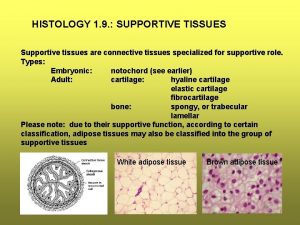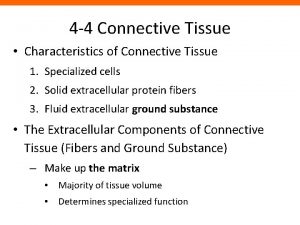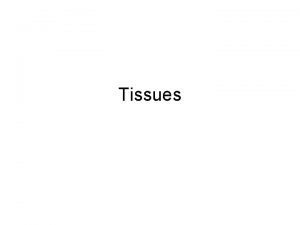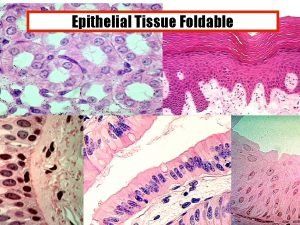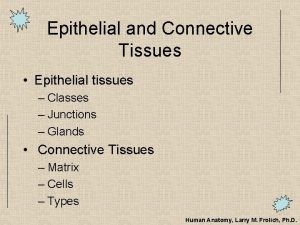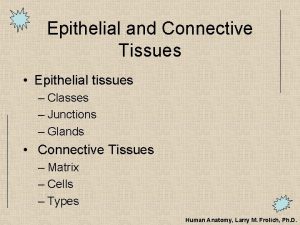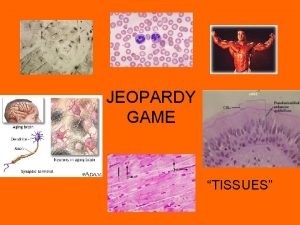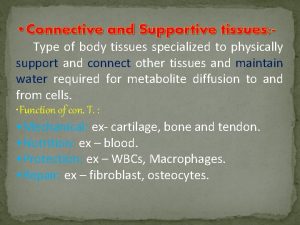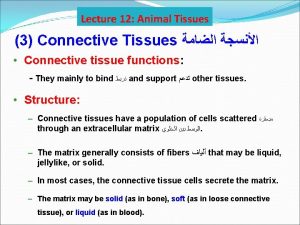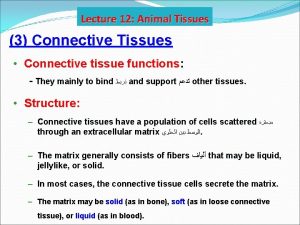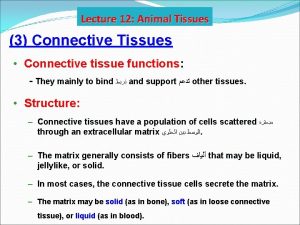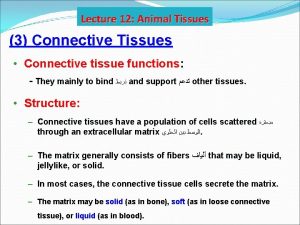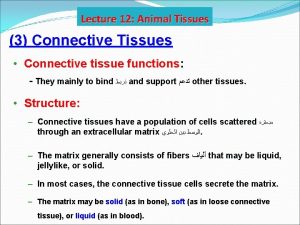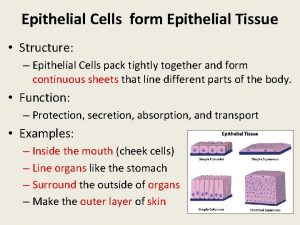THE GROUND TISSUES EPITHELIAL TISSUES CONNECTIVE AND SUPPORTIVE

























- Slides: 25

THE GROUND TISSUES EPITHELIAL TISSUES CONNECTIVE AND SUPPORTIVE TISSUES MUSCLE TISSUES NERVOUS TISSUE

HISTOLOGY 1. 3. : EPITHELIAL TISSUES 1. SURFACE EPITHELIA Diverse group of tissues, cover or line external and internal body surfaces, cavities and tubes, thus, function as interfaces between different biological compartments. Epithelia mediate a wide range of activities: • selective diffusion • absorption • secretion • physical protection • sensory function Origin of the epithelial tissues: • ectoderm (corneal epithelium, epidermis of skin, glands) • entoderm (alimentary tract, intestinal glands, liver, pancreas) • mesoderm (kidney, male and female reproductive system, endothelium, mesothelium)

Blood supply of the epithelial tissue: normally it is avascular exception: pharyngeal epithelium of frog urinary bladder of rabbit Nerve supply of the epithelial tissue: it is an innervated tissue containing free nerve endings and nerve endings associated to specialized cells of sensory function Tissue components of epithelial tissues: • Cells (squamous, cuboidal, columnar) closely packed • Intercellular matrix is reduced to the glycocalyx of the adjacent cells

THE POLARITY OF THE EPITHELIAL CELLS

Membrane modifications of the apical surface of epithelial cells: cilia Membrane specialization of the basal membrane surface of epithelial cells: basal striation + basal lamina (green arrows)

CLASSIFICATION OF EPITHELIAL TISSUES FUNCTIONAL BASIS: SURFACE EPITHELIA GLANDULAR EPITHELIA ABSORPTIVE EPITHELIA PIGMENT EPITHELIA SENSORY EPITHELIA

SURFACE EPITHELIA: Further classification: on the basis of the number of cell layers on the basis of the shape of the cells Simple epithelia: a single layer of cells simple squamous simple cuboidal simple columnar Pseudostratified epithelia: single layer of cells, with nuclei in more than one layer pseudostratified columnar transitional Stratified epithelia: several layers of cells on top of each other stratified squamous (non-keratinized, keratinized) stratified cuboidal stratified columnar

Simple epithelia: simple squamous epithelium

OCCURRENCE OF SIMPLE SQUAMOUS EPITHELIUM IN THE BODY • PULMONARY ALVEOLI • PARIETAL LAYER OF BOWMAN’S CAPSULE – KIDNEY • THIN SEGMENTS OF HENLE’S LOOP – KIDNEY • RETE TESTIS • INNER ASPECT OF THE TYMPANIC MEMBRANE IN THE MIDDLE EAR • ENDOTHELIUM LINING THE BLOOD AND LYMPHATIC VESSELS • SEROUS MEMBRANES LINING BODY CAVITIES AND INTERNAL ORGANS

SOME EXAMPLES: Cross-section of the simple squamous epithelium: Kidney glomerulus, Bowman’s capsule Mesothelial lining of the peritoneal cavity: „fried-egg” appearance

Endothelium: lining of the blood vessels and heart (arrows). Note the flattened nuclei The alveoli of the lung are composed of similar cells

Simple epithelia: simple cuboidal epithelium

OCCURRENCE OF SIMPLE CUBOIDAL EPITHELIUM IN THE BODY • LINING THE FOLLICLES IN THE THYROID GLAND • THE SURFACE OF OVARY • CHOROID PLEXUS – BRAIN • THE CAPSULE OF LENS – EYE • PIGMENTED EPITHELIUM OF RETINA – EYE • DUCTS OF MANY GLANDS • SECRETORY ACINI OF MANY GLANDS • SEVERAL SEGMENTS OF KIDNEY TUBULES

Kidney: proximal and distal convoluted tubules, collecting tubules are lined by simple cuboidal epithelium Proximal tubules in cross-section and in longitudinal section (arrow)

The follicles of the thyroid gland are formed by simple cuboidal cells

Simple epithelia: simple columnar epithelium

OCCURRENCE OF SIMPLE COLUMNAR EPITHELIUM IN THE BODY • DIGESTIVE TRACT FROM THE CARDIA OF THE STOMACH TO THE ANUS • LARGER EXCRETORY DUCTS OF SOME GLANDS • UTERUS (CILIATED) IN HUMAN • OVIDUCT (CILIATED) IN HUMAN • PULMONARY BRONCHI (CILIATED) - LUNG • PARANASAL SINUSES – NOSE • CENTRAL CANAL OF SPINAL CORD (EPENDYMA)

Pseudostratified epithelia: pseudostratified columnar epithelium

OCCURRENCE OF PSEUDOSTRATIFIED COLUMNAR EPITHELIUM • THE MALE URETHRA • EPIDIDYMIS – MALE GENITAL ORGAN • TRACHEA (CILIATED) • PRIMARY BRONCHI (CILIATED) – LUNG • THE AUDITORY TUBE • PART OF THE TYMPANIC CAVITY – EAR • LACRIMAL SAC

Transitional epithelium, or urothelium

Urinary bladder, fixed in empty state: note thickness of the urothelium: 8 -10 cell layers (arrow) Urinary bladder, fixed in full state: note thickness of the urothelium: 4 -5 cell layers (arrow)

The luminal surface of the umbrella cells is covered by a specialized cell membrane called calyx, or crusta

Stratified epithelia: stratified squamous non-keratinized epithelium Layers from the basal lamina to the surface: • stratum basale/germinativum: columnar cell layer with mitotic division • stratum spinosum: cuboidal poligonal cell layers with many desmosomes • stratum planocellulare: fusiform or flattened cell layers Occurrence: cornea, internal body surfaces, e. g. esophagus (see above)

Stratified epithelia: stratified squamous keratinized epithelium 4. 5. Str. corneum 1. 3. 2. Layers from the basal lamina to the surface: 1. stratum germinativum, 2. stratum spinosum, 3. stratum granulosum (fusiform cells with keratohyalin granules), 4. stratum lucidum (flattened layer with eleidin), 5. stratum corneum (dead cell layer) Occurrence: epidermis of skin, beginning and end-portions of the gastrointestinal tract

STRATIFIED CUBOIDAL EPITHELIUM VERY RARE: TWO ROWS OF CUBOIDAL CELLS ON TOP OF EACH OTHER Duct of the sweat gland (cisterna lactis of teat- not shown) STRATIFIED COLUMNAR EPITHELIUM: Cavernous urethra, Large excretory ducts of some glands, Larynx (ciliated), Fetal esophagus (transiently)
 Body tissue
Body tissue Four major tissue types
Four major tissue types Body tissues chapter 3 cells and tissues
Body tissues chapter 3 cells and tissues Chapter 3 cells and tissues
Chapter 3 cells and tissues Supportive tissue
Supportive tissue Adipose epithelial tissue
Adipose epithelial tissue Cells form tissues. tissues form __________.
Cells form tissues. tissues form __________. What are specialized connective tissue
What are specialized connective tissue Connective tissue
Connective tissue Areolar tissue location and function
Areolar tissue location and function What do all connective tissues have in common
What do all connective tissues have in common What is supportive discipline
What is supportive discipline High directive and high supportive behavior
High directive and high supportive behavior Models of case work
Models of case work High directive and low supportive behavior
High directive and low supportive behavior Casts in urine
Casts in urine Layers of epithelial tissue
Layers of epithelial tissue Simple columnar tissue function
Simple columnar tissue function Epithelial dysplasia oral
Epithelial dysplasia oral Transseptal fiber
Transseptal fiber Schema tissu epithelial
Schema tissu epithelial Epitelio glandular holocrino
Epitelio glandular holocrino Basal lamina
Basal lamina Epithelial tissue pogil answer key
Epithelial tissue pogil answer key Epithelial tissue
Epithelial tissue Dental sac
Dental sac




